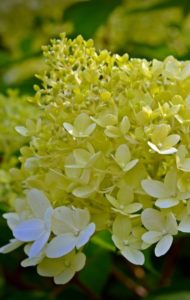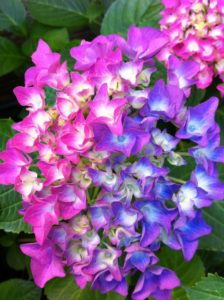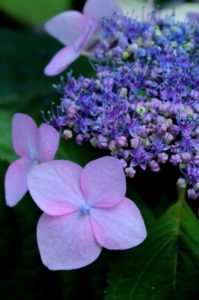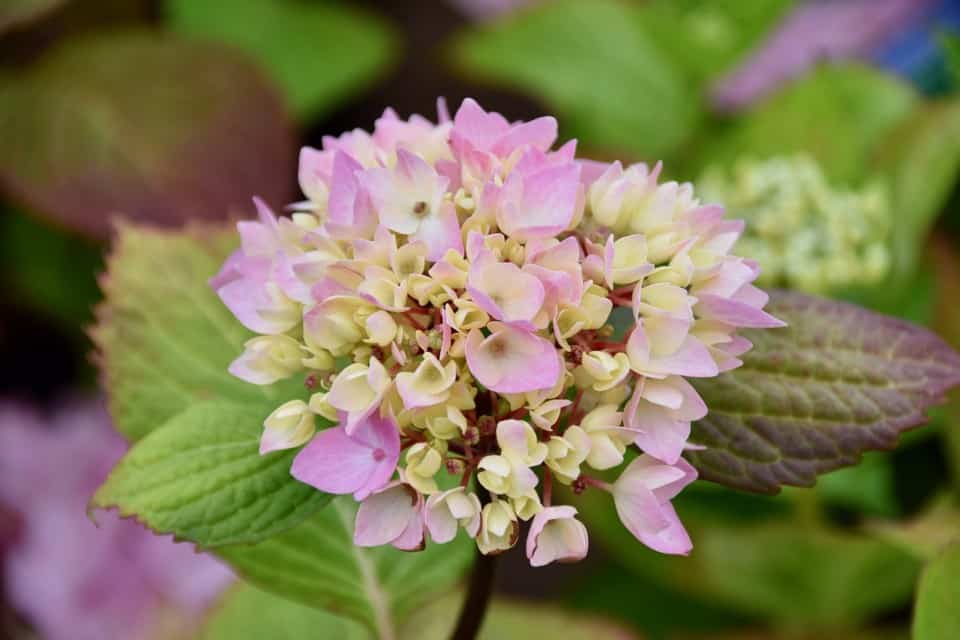Some links in the post are affiliate links and I get a commission from purchases made through some links found in the post.
Hydrangeas have a long and cherished history dating back to millions of years.
These pretty flowers are a testament to the common heritage we share as a species as they are native to many different geographical locations spread out all across the globe.
According to folklore, hydrangeas were first cultivated in Japan but have been traced to Europe and the Americas.
Whatever the origin of these beautiful flowers might be, there is no denying that their aesthetic appeal is irresistible.
In the USA, the first cultivation of hydrangeas dates back to 1776 when botanist William Bartram discovered H.quercifolia, a variety of hydrangea native to Georgia.
This variety and H.Arborescens made way for cultivated hydrangeas which soon spread across all states. Today, there are many different varieties of hydrangea, each having its distinct characteristics and essence.
This timeless flower has seen many ups and downs, but it is witnessing a comeback as a popular addition to any garden because of its charismatic beauty.
Why Does My Hydrangea Have Small Flowers
One of the most everyday problems people face while cultivating a hydrangea is that it’s flowers do not bloom properly, which can be pretty discouraging, to be honest.
But you can successfully navigate through this issue if you understand why your hydrangea has small flowers in the first place.
The most common reason your hydrangea will have small flowers is due to excess nitrogen, lack of water, too much shade, deers, pruning issues and too much sunlight.
All of these can be sorted with ideal care practices and protecting your hydrangea.
A thorough understanding of the plant will help you immensely while cultivating hydrangea and getting a beautiful bloom.
To know more about this beautiful plant, we will first dive into its subtypes and features to address the most common problems people face while growing hydrangeas.
Some Popular Types Of Hydrangeas
 Broadly speaking, hydrangeas fall into the following categories.
Broadly speaking, hydrangeas fall into the following categories.
Smooth, oakleaf, bigleaf, climbing, and panicle. Big leaf hydrangeas are the most common variety of plants found in the USA.
They are also called florist hydrangeas because of their frequent use in bouquets.
Mophead hydrangeas, lacecap hydrangeas, and mountain hydrangeas are common examples of big leaf hydrangeas. Oakleaf hydrangea is so named because its leaves resemble a red oak.
Oakleaf hydrangeas grow well in places where sunlight is plenty. They can make do even with little or no shade at times.
Climbing hydrangeas are natives of Asia and are commonly found in Japan and Korean Peninsula. They are famous for growing large structures and producing a spectacular bloom.
Panicle hydrangeas are known for their cone-shaped flower heads, which are pretty easy to spot.
They are among the hardiest varieties of hydrangeas because of their ability to withstand extreme cold. Smooth hydrangeas, on the other hand, grow well in warmer climates.
You can grow them in colder climates, but they tolerate hotter temperatures better. While lack of blooming can be a problem with any of these types, gardeners have singled out bigleaf in particular as troublesome to cultivate.
Why is that, and how to counter this problem? This article has got you covered!
Most Common Reasons Of Your Hydrangea Having Small Flowers
Many things can go wrong with your plant, but we have narrowed it down to the most common problems people face.
If you want your flowers to bloom properly, it will be wise to take precautions in advance to protect your plants from these conditions. The most common reasons of your hydrangea having small flowers is:
1) Excessive Nitrogen
Nitrogen is a crucial component in all fertilizers. It is a vital requirement for all plants, but as they say, excess of anything can be harmful, particularly in the case of nitrogen.
While plants require nitrogen to form new leaves, phosphorus is critical for developing fruit, flowers, and seeds.
If your plant is getting more nitrogen at the expense of phosphorus, it won’t bloom properly, and your hydrangea will have small flowers.
So it is critical to ensure that your plant is getting all the essential nutrients in a balanced way. If you are unsure whether nitrogen is the culprit, you don’t need to do much.
A simple soil test will help you in detecting the problem. After recognizing the problem, the solution is pretty simple.
You need to use a slow-release fertilizer to balance nitrogen and phosphorus. And just like that, your issue will be solved!
2) Lack Of Water
Well, this is a no-brainer. Hydrangeas are notorious for their excessive water requirement.
All species of hydrangeas love moisture to varying degrees and will refuse to grow if not provided with the minimum amount of water.
If you live in a hot and dry climate, then perhaps you need to do more to ensure your hydrangeas are getting the moisture they require.
While mother nature helps us cater to the moisture requirements through rain, it can often be unreliable during drought. The solution? Find an alternative source of irrigation for your hydrangeas and save them from wilting out.
To help you out we have created an article on how much water your hydrangea needs here.
3) Too Much Shade
Excessive shade can also disrupt the growth of your hydrangeas. This problem is particularly common if you are growing hydrangeas under trees.
Gradually as the trees grow, they will restrict the amount of sunlight reaching the ground, and as a result, your hydrangeas won’t bloom properly.
Some amount of shade is essential for your plants but make sure that they are getting an adequate amount of sunlight.
Because excessive shade can hamper their growth, it can leave you with tiny flowers. Finding the right balance can be difficult but it is essential if you want your hydrangea to produce beautiful flowers!
4) Deers
Deers love to feed on hydrangeas. If you live in an area where there is a sizable population of deers close by, perhaps you should note this problem.
An easy way to detect deers feeding on your hydrangeas is by closely observing the leaves.
If they seem partly eaten having rough edges, then deers are the most likely culprit. In that case, you will need to make some fencing to protect your hydrangeas and guard them against deers.
This simple solution will solve your problem of having small flowers.
5) Pruning Issues
If you have ruled out all of the above and still are not sure about what is wrong with your hydrangeas, then maybe you are pruning them in the wrong way.
Pruning a hydrangea is a delicate art and needs to be done correctly with great care. Avoid pruning in autumn to late spring because that is the time when your flowers are growing.
Summer is the perfect time for pruning because that will give you enough time to bloom in spring. That being said, pruning hydrangeas is really tricky, and every variety has different requirements.
So it is a good idea to get more information about your variety and act accordingly.
6) Too Much Sunlight

Just like too much shade is harmful to your plant, too much sunlight can also cause problems with blooming. Excessive sunlight can put plants under stress.
Stressed-out plants can skip blooming to conserve energy leaving you with tiny flowers. If your leaves have a brown or golden tint or look wilted, then excessive sunlight is likely to cause small flowers.
Change their position to somewhere with a little more shade, and you will notice the change soon!
You may also like: How do you get rid of black spots on hydrangea leaves
How To Produce Larger Flowers On Your Hydrangeas
In the previous section, we have covered some of the common issues that might be causing your hydrangea to grow small flowers.
However, it is not difficult to produce larger flowers on your hydrangeas if you take proper precautions against these problems.
Hydrangeas are not fussy plants, but they need love, care, and attention. This section will guide you about the steps you can take to produce larger flowers on your hydrangeas.
-
Choose The Right Variety
Doing everything right but still not getting the desired result?
Don’t worry. Sometimes it’s not your fault. Some hydrangeas varieties tend to produce larger flowers than others. So it is essential to choose a suitable type.
Mathilda Gutges, glowing embers, nikko blue, and all summer beauty are some of the varieties which are famous for their beautiful large flowers.
-
Choosing The Right Amount of Fertilizer
You have to make sure your hydrangeas are getting all the minerals they need and in the required amount.
The nutritional balance is vital for any plant but particularly more for hydrangeas. If you are using a fertilizer with high nitrogen content, they can grow leaves instead of flowers.
Choose a fertilizer with nitrogen, phosphorus, and potassium in equal parts. Follow the instructions given on the back of your fertilizer packing.
Always remember too much of even a good thing is always bad. Make sure to dilute the fertilizer properly before using it.
We have created an article on how to make a natural fertilizer for your hydrangea to help you fertilize your plant.
-
Plant Your Hydrangeas In Appropriate Place
It is important to choose the right place to plant your hydrangeas. A place where they will get adequate sunlight but not too much as this will cause them to stress out.
It is difficult to find the right balance between the amount of sunlight and shade your plant requires but as a general rule, if you live in a warm climate where sunlight is plenty, you can move more towards the shade. Similarly, if you live in colder weather, perhaps your plant can thrive with less shade than usual.
-
Ensure Your Hydrangeas Are Getting Proper Moisture
As the name implies, hydrangeas just love water. They cannot have enough of it. So to have a proper bloom, you need to tend to the moisture requirements of your plants.
But like in everything else, a balance is essential here as well. If you keep your hydrangeas standing in the water, they won’t grow properly.
Instead, they liked to be soaked in water. A good way of checking whether your plants are getting enough water or not is to check the soil, mud underneath.
If the soil is wet, you do not need to do much. But if it is dry, that is a sign of your hydrangeas not getting enough moisture. Watering your hydrangeas deeply can bring a dramatic improvement in the quality of flowers.
You may also like: Why are my hydrangea leaves curling
Does Deadheading Hydrangeas Produce More Blooms
Deadheading your hydrangeas will produce more blooms, but only if you do it correctly. If done right and at the appropriate time, deadheading will go a long way in improving your hydrangeas.
They won’t just bloom better but look tidier as well. Deadheading allows you to remove spent flowers to make room for new ones.
Deadheading is different for different varieties of hydrangeas. For example, types like the endless summer should be deadheaded around the time when flowers are sprouting from last spring’s growth.
In this way, you will get rid of faded flowers before the next bloom appears.
On the other hand, Smooth hydrangeas need to be deadheaded soon after they start to fade to green. So it is essential to know about the exact deadheading requirements of your variety.
Ideally, you should locate the first set of full-sized leaves you can find under the flower and make the cut just above it. In this way, you will remove dead flowers to reveal a new set of healthy leaves.
Which Hydrangeas Should Not Be Cut Back
Some new generations of hydrangeas do not need to be pruned at all!
Known as remontant or reblooming hydrangeas, these varieties bloom on old and new wood. Typically they do not need pruning at all. But you do have to tend to the dead, diseased or damaged parts, if any.
Final Thoughts
 Growing hydrangeas is pretty easy if you are careful about the requirements of your plant.
Growing hydrangeas is pretty easy if you are careful about the requirements of your plant.
Hydrangeas can be a fantastic addition to your garden, adding lots of colors and beauty as well as aesthetic appeal.
But they need to be cared for if you want them to bloom properly. Having smaller flowers than expected with hydrangeas can be a problem, but only if you are not giving your plant proper attention.
If you are cautious about your hydrangeas’ requirements, you do not need to worry about having small flowers.
Just make sure they are getting the right balance of moisture, sunlight, and minerals, and get ready to be dazzled by the exceptional beauty of your hydrangeas.
But If you leave them unattended or poorly cared for, then you are heading for disappointment for sure. Follow our tips to grow beautiful and vibrant hydrangeas that will give a lovely feel to your garden.
If you enjoyed this article, check out our article on hydrangeas vs lilacs.
About the Author:
Saad Ansar
Saad is an avid gardener himself and is a great lover of plants, animals, photography, & people. Currently, he is focused on photographing indoor plants & captioning beautiful outdoor sceneries. He writes and rewrites in-depth articles on nature and science.


